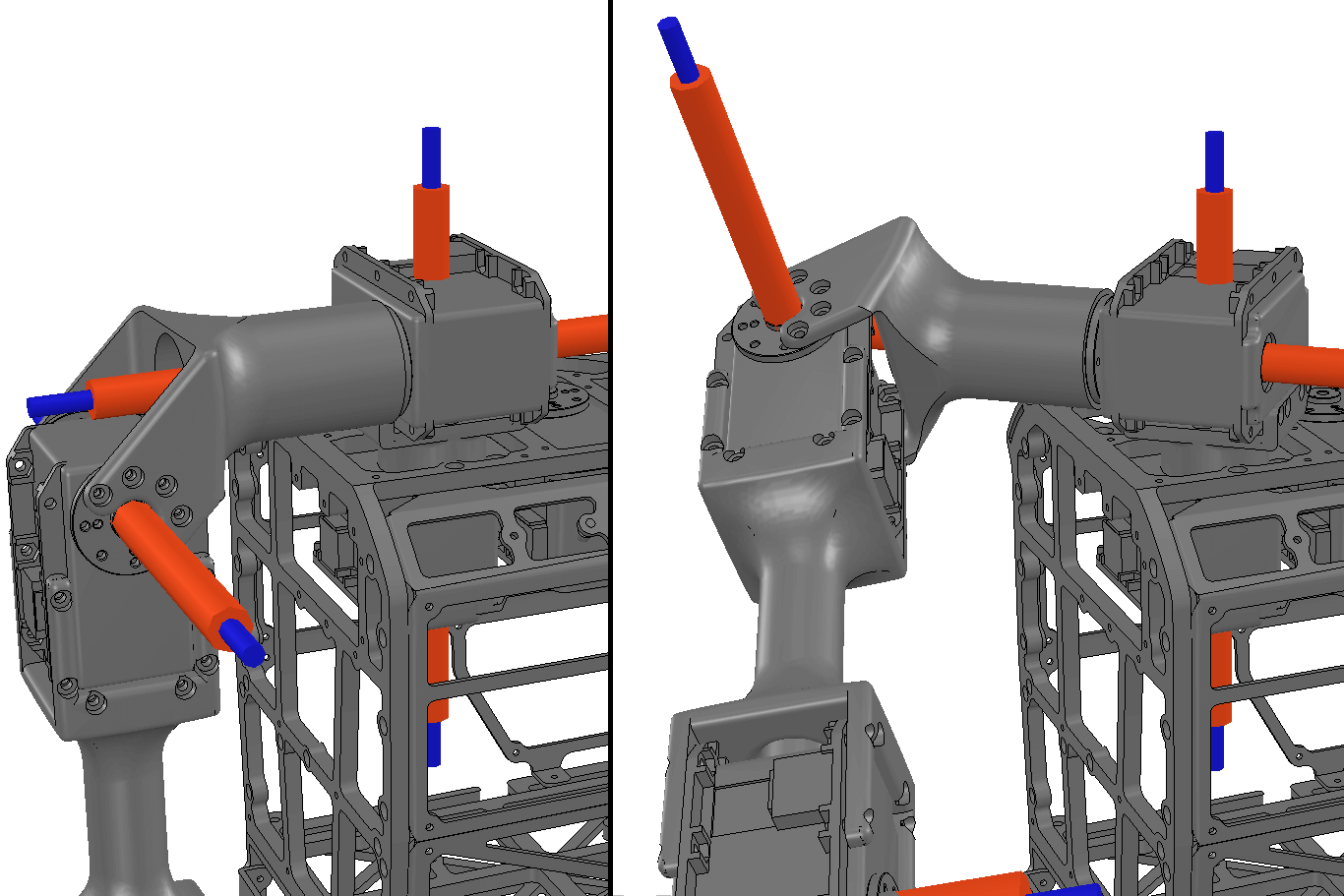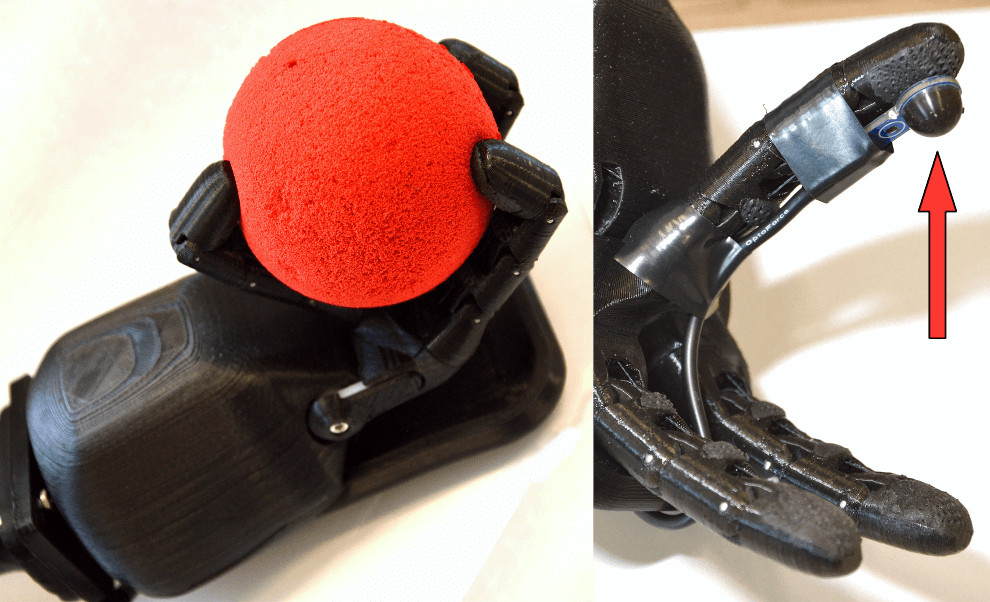NICO - Technical Details

The NICO robot is designed as a highly flexible and modular platform for multimodal human-robot interaction and neuro-cognitive
Redesign mainly took place in the upper body including
- the neck and the head, with a strong emphasis on the audio and visual sensory modalities and a display for facial expressions as well as
- the shoulders, the arms, and the hands, with a focus on advanced manipulation.
Degrees of Freedom (DoF)
 In total, the robot has 30 DoF which are distributed as follows:
In total, the robot has 30 DoF which are distributed as follows:
- Two DoF can perform yaw and pitch movements of the head.
- The shoulders feature a tight cluster of motors that offer three DoF, mimicking the physiology of the human shoulder ball joint.
- One degree of freedom allows bending at the elbows.
- Seed Robotics SR-DH4D articulated hands
add four DoFs for wrist rotation, wrist flexion, controlling the two index fingers, and controlling the opposable thumb. - Each leg includes three DoF in the hip joint, one DoF in the knee and two DoF in the foot. Due to its modular design, the legs can be removed at the hip, if not required, and the torso can be mounted on a wheeled platform.
Head
 The outer shell of the robot’s head is based on the open-source design of
The outer shell of the robot’s head is based on the open-source design of
Visual Modality
NICO’s head houses two parallel camera mounts with exchangeable lenses and can be equipped with a variety of cost-effective or state-of-the-art electronics such as the 2 Megapixel sensor of a Logitech C905. Additionally, the mounts include holders for the optics that enable to adapt the optics to different scenarios. This way the NICO can e.g. include wide-angle optics with a field of view of 180 degrees or research in RoboCup football, or lenses that mimic a human-like field of view (70°) for research in bio-inspired perception models.
Auditory Modality
The head is endowed with two Soundman OKM II binaural microphones embedded in realistically shaped and 3D-printed pinnae. This design is particularly convenient to study human-like binaural hearing for sound source localization (SSL) and speech recognition. Specifically for SSL, the interaural time and level differences for sounds perceived by both ears are essential. Thus, the location of the microphones, the dampening factor of the head, and also the form of the pinnae (necessary for vertical SSL) have been carefully designed close to human-child anatomy for providing a realistic distortion of the sounds. In contrast to other humanoids such as iCub, NICO’s head does not include any moving part, computing unit, or cooling device. This minimizes the ego-noise that can superimpose to frequency components that are important for speech recognition.
Emotion Expression
 NICO’s head is also fitted with three LED arrays in the mouth and eye areas. These arrays enable the NICO robot to show stylized facial expressions during human-robot interaction
NICO’s head is also fitted with three LED arrays in the mouth and eye areas. These arrays enable the NICO robot to show stylized facial expressions during human-robot interaction
Upper Body
 The open design of NimbRo-OP allowed redesigning the torso and shoulder area including a modified placement of motors inside the torso, improving the robot’s working space to enable better bi-manual manipulation in front of the body.
The open design of NimbRo-OP allowed redesigning the torso and shoulder area including a modified placement of motors inside the torso, improving the robot’s working space to enable better bi-manual manipulation in front of the body.
We have moved the first joint inside the space of the torso frame to gain space and mounted the second
For multimodal human-robot interaction, the human-like kinematics of the arm and hand provides the added advantage of enabling the robot to learn grasping and gestures from human demonstration.
3-Finger Hands
 For the hands, we integrated the three-fingered SR-DH4D hands from Seed Robotics into the NICO. Their tendon-based mechanics with force feedback allow for segmented, bendable fingers with three joints per finger and thus for seamless handling of objects with different shapes. The two index fingers are controlled together as a single DoF as is the opposable thumb, which reduces the complexity of the grasping or object manipulation while still preserving the advantages of a fingered hand over a rigid gripper. The hands use the Dynamixel bus system and protocol and can, therefore, be seamlessly integrated into the control framework of the NICO robot.
For the hands, we integrated the three-fingered SR-DH4D hands from Seed Robotics into the NICO. Their tendon-based mechanics with force feedback allow for segmented, bendable fingers with three joints per finger and thus for seamless handling of objects with different shapes. The two index fingers are controlled together as a single DoF as is the opposable thumb, which reduces the complexity of the grasping or object manipulation while still preserving the advantages of a fingered hand over a rigid gripper. The hands use the Dynamixel bus system and protocol and can, therefore, be seamlessly integrated into the control framework of the NICO robot.
Haptic Sensors
In humans, the haptic sensory modality subsumes two distinct sensory subsystems (Lapeyre et al., 2014):
- The tactile modality is perceived via sensory cells in the skin that react to deformation, vibration, and temperature.
- Proprioception provides information about the body posture, movement and exerted forces.
The integration of haptic sub-modalities is required for haptic exploratory procedures such as lateral motions for texture information, unsupported holding for weight information, or contour following for shape information. For tactile sensing, we integrated OPTOFORCE OMD-10-SE-10N 7 force sensors, see Figure 4 (right). This sensor consists of a rubber dome that can measure pressure and
the movement direction during lateral motions reveal static friction. Once the static friction is overcome, both low and high-frequency vibrations can be observed, giving information about regularities in the texture, e.g. a corrugated surface and sliding friction respectively. Combining information about
these properties can accomplish discrimination of various materials and adds a novel modality to the NICO which can, for instance, be used to learn an embodied understanding of haptic adjectives (Chu et al., 2013).
Proprioceptive information such as torque from the motors can be combined with tactile information from the OPTO-FORCE OMD-10-SE-10N sensors on the fingertips to provide a haptic sensory modality for the NICO robot.
